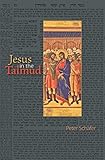Jesus in the Talmud / Peter Schäfer.
Material type: TextPublisher: Princeton, NJ : Princeton University Press, [2009]Copyright date: ©2007Edition: Course BookDescription: 1 online resource : 1 halftoneContent type:
TextPublisher: Princeton, NJ : Princeton University Press, [2009]Copyright date: ©2007Edition: Course BookDescription: 1 online resource : 1 halftoneContent type: - 9780691143187
- 9781400827619
- online - DeGruyter
- Issued also in print.
| Item type | Current library | Call number | URL | Status | Notes | Barcode | |
|---|---|---|---|---|---|---|---|
 eBook
eBook
|
Biblioteca "Angelicum" Pont. Univ. S.Tommaso d'Aquino Nuvola online | online - DeGruyter (Browse shelf(Opens below)) | Online access | Not for loan (Accesso limitato) | Accesso per gli utenti autorizzati / Access for authorized users | (dgr)9781400827619 |
Frontmatter -- Contents -- Acknowledgments -- Abbreviations -- Introduction -- 1. Jesus' Family -- 2. The Son/Disciple Who Turned out Badly -- 3. The Frivolous Disciple -- 4. The Torah Teacher -- 5. Healing in the Name of Jesus -- 6. Jesus' Execution -- 7. Jesus' Disciples -- 8. Jesus' Punishment in Hell -- 9. Jesus in the Talmud -- Appendix: Bavli Manuscripts and Censorship -- Notes -- Bibliography -- Index
restricted access online access with authorization star
http://purl.org/coar/access_right/c_16ec
Scattered throughout the Talmud, the founding document of rabbinic Judaism in late antiquity, can be found quite a few references to Jesus--and they're not flattering. In this lucid, richly detailed, and accessible book, Peter Schäfer examines how the rabbis of the Talmud read, understood, and used the New Testament Jesus narrative to assert, ultimately, Judaism's superiority over Christianity. The Talmudic stories make fun of Jesus' birth from a virgin, fervently contest his claim to be the Messiah and Son of God, and maintain that he was rightfully executed as a blasphemer and idolater. They subvert the Christian idea of Jesus' resurrection and insist he got the punishment he deserved in hell--and that a similar fate awaits his followers. Schäfer contends that these stories betray a remarkable familiarity with the Gospels--especially Matthew and John--and represent a deliberate and sophisticated anti-Christian polemic that parodies the New Testament narratives. He carefully distinguishes between Babylonian and Palestinian sources, arguing that the rabbis' proud and self-confident countermessage to that of the evangelists was possible only in the unique historical setting of Persian Babylonia, in a Jewish community that lived in relative freedom. The same could not be said of Roman and Byzantine Palestine, where the Christians aggressively consolidated their political power and the Jews therefore suffered. A departure from past scholarship, which has played down the stories as unreliable distortions of the historical Jesus, Jesus in the Talmud posits a much more deliberate agenda behind these narratives.
Issued also in print.
Mode of access: Internet via World Wide Web.
In English.
Description based on online resource; title from PDF title page (publisher's Web site, viewed 08. Jul 2019)


